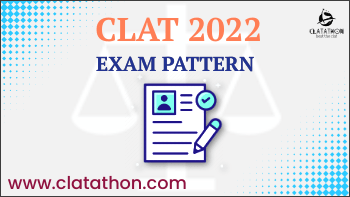CLAT UG Exam Pattern
The Consortium of NLUs conducts the Common Law Admission Test or CLAT for admissions to 5-year integrated law programmes. The exam is a national level entrance test that allows aspiring law candidates to study in the top National Law Universities and other prestigious law institutions in India. The CLAT-UG exam is designed to test the aspirants' knowledge of English, Legal Reasoning, Logical Reasoning, General Knowledge and Quantitative Techniques.
The consortium of NLUs has described the CLAT-UG Exam Pattern for the Aspirants to be acquainted with the sections, types of questions and the exam difficulty level. The exam pattern provides all the details about the CLAT Test modalities. In 2020, the CLAT-UG exam pattern saw a significant change due to the COVID spread. The number of questions in the exam were reduced from 200 to 150, and the consortium introduced comprehension-based questions followed by 5/6 questions. However, it is expected that in 2022, CLAT will be conducted in offline mode.
Every skill required to become a successful lawyer gets tested in CLAT. To ace CLAT, an aspirant must have an in-depth understanding of the CLAT exam pattern to devise a strong strategy for the exam and to be able to attempt all five sections with proficiency and expertise.
The following analysis would give you a clear picture of the CLAT-UG Exam Pattern and help in your preparation:
CLAT UG Exam Pattern: Overview
|
Nomenclature |
Details |
|
Number of Sections |
5 |
|
Sections |
English including Comprehension, General Knowledge and Current Affairs, Legal Reasoning; Logical Reasoning, Quantitative Techniques |
|
Total no. of questions |
150 |
|
Total marks |
150 |
|
Marks per question |
1 |
|
Negative Marking |
Yes (0.25 deducted for wrong answer) |
|
Mode of Examination |
Offline |
CLAT UG Exam Pattern: Section-wise Distribution
|
SL. No. |
Subjects |
Questions(approx.) |
|
1 |
English including Comprehension |
28-32 |
|
2 |
General Knowledge and Current Affairs |
35-39 |
|
3 |
Legal Reasoning |
35-39 |
|
4 |
Logical Reasoning |
28-32 |
|
5 |
Quantitative Techniques |
13-17 |
CLAT UG Exam Pattern: Importance
Aspirants who will be appearing for CLAT-UG 2022 must have thorough knowledge about the CLAT Exam Pattern. Upon knowing about the exam pattern, the Aspirant will learn about the exam mode, sections, the number of questions, marks distribution, duration and difficulty level. It also focuses on helping the Aspirant understand what questions can be asked and what skills Aspirants are tested upon. Thus, every Aspirant needs to be acquainted with the modalities of the exam.
The most significant change introduced in CLAT-UG 2020 was that there would be no Legal Aptitude Section, it is called Legal Reasoning. Students should expect comprehension-based questions from English, Quantitative techniques, Current Affairs, Legal Reasoning and Logical Reasoning.
CLAT UG Exam Pattern: Key Features
. Another significant change was the reduction in the number of questions. In CLAT 2022, students can expect 150 questions, and total marks will be 150.
. The CLAT exam is expected to be pen-paper based. Upon the release of the final exam date, the information about the examination mode will be released.
. There is no change in the duration of the exam. The CLAT-UG 2022 will be for 120 minutes.
. The change in the pattern indicates the stress on the reading abilities of the CLAT aspirant. Aspirants have to be skilled in inferential reasoning, and Aspirants with a good reading habit will be better positioned to crack CLAT-UG.
. CLAT-UG exam will comprise passages of 450-500 words containing 5-6 questions.
. Reading skills are important as each section will contain passages and questions related to it.
. The Aspirant needs to be quick in reading and understanding the passages to answer the questions efficiently and in time
. Aspirants must strategize their time to complete the examination in the given time and with 100% accuracy.
Thus, to prepare well for the exams, you must be through with the CLAT Exam Pattern. For more information about the CLAT, you can visit the official CLAT website.

